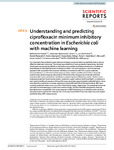2020-09-14Zeitschriftenartikel
Understanding and predicting ciprofloxacin minimum inhibitory concentration in Escherichia coli with machine learning
Pataki, Bálint Ármin
Matamoros, Sébastien
van der Putten, Boas C. L.
Remondini, Daniel
Giampieri, Enrico
Aytan-Aktug, Derya
Hendriksen, Rene S.
Lund, Ole
Csabai, István
Schultsz, Constance
SPS COMPARE ML-AMR Group
It is important that antibiotics prescriptions are based on antimicrobial susceptibility data to ensure effective treatment outcomes. The increasing availability of next-generation sequencing, bacterial whole genome sequencing (WGS) can facilitate a more reliable and faster alternative to traditional phenotyping for the detection and surveillance of AMR. This work proposes a machine learning approach that can predict the minimum inhibitory concentration (MIC) for a given antibiotic, here ciprofloxacin, on the basis of both genome-wide mutation profiles and profiles of acquired antimicrobial resistance genes. We analysed 704 Escherichia coli genomes combined with their respective MIC measurements for ciprofloxacin originating from different countries. The four most important predictors found by the model, mutations in gyrA residues Ser83 and Asp87, a mutation in parC residue Ser80 and presence of the qnrS1 gene, have been experimentally validated before. Using only these four predictors in a linear regression model, 65% and 93% of the test samples’ MIC were correctly predicted within a two- and a four-fold dilution range, respectively. The presented work does not treat machine learning as a black box model concept, but also identifies the genomic features that determine susceptibility. The recent progress in WGS technology in combination with machine learning analysis approaches indicates that in the near future WGS of bacteria might become cheaper and faster than a MIC measurement.

